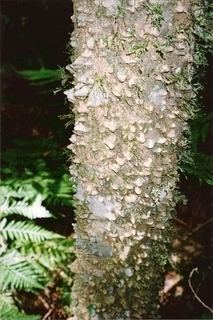Kingdom Plantae Family Rutaceae Rank Species | Order Sapindales Genus Zanthoxylum | |
 | ||
Scientific name Zanthoxylum brachyacanthum Similar Zanthoxylum kauaense, Zanthoxylum hawaiiense, Zanthoxylum thomasianum | ||
Zanthoxylum brachyacanthum, known as thorny yellowwood or satinwood, is an Australian rainforest tree. The natural range is from the Clarence River (29° S) in New South Wales to tropical Queensland in the Eungella National Park and the Wet Tropics region.
Contents
This tree is in the family Rutaceae, which is sometimes known as the "citrus family" because this family also contains all of the species (such as the orange, lemon, etc.) in the genus Citrus.
This tree grows on a variety of subtropical, tropical and drier rainforests, often on volcanic soils. Young trees are easily identified in the rainforest by the thorny trunk and the dark green glossy leaves.
The leaves of Zanthoxylum brachyacanthum serve as a food plant for butterfly larvae including those of the orchard swallowtail butterfly and the fuscus swallowtail.
Description
This is a small tree, up to 15 metres tall and 35 cm around the trunk. The bark is grey, wrinkled and features sharp pointed lenticels on young trees. Older trees appear more smooth barked. Trees are mostly not buttressed or flanged at the base.
The leaves are alternate and pinnate, with five to sixteen shiny leaflets. Leaflets are alternate, 4 to 9 cm long, egg shaped or oblong, usually toothed and with evident oil glands. The branchlets have prickles and are green or blue/green. The leaf scars are noticeable.
The flowers appear on panicles from October to November. They are pink or red, with a yellowish centre. The flowers are very attractive to insects because of their nectar.
The fruit matures from February to May, being a single cocci, bright red and shiny. It later changes color to a wrinkled dark brown, each fruit being 10 mm long. The cocci splits into two valves, with one black seed each, and are 6 mm long and shiny, attached by a membrane of a similar length. The seed germination is erratic.
Uses
This tree's small size, the interesting trunk, the attractive flowers and foliage makes the thorny yellowwood suitable as an ornamental plant. The timber is deep yellow and close grained, and thus it is suitable for decorative work.
The plant family contains some interesting alkaloids, coumarins, furano coumarins, and pryanocoumarins, ancetophenones such as Zantholoxylin, flavanoids like amurensin, and polyhydroxol flavainoids, and Amides.
The essential (leaf) oil of Z. brachyacanthum was rich in α-pinene (46%), β-caryophyllene (14%) and bicyclogermacrene (12.5%).
